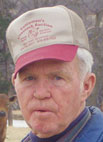
Odell and Evelyn Ray of Berryville, Ark., have lived the city life, as well as the country life. Both of them agree they are blessed to have been able to return to their roots in Carroll County, Ark. Odell was raised very near their present farm, and Evelyn was raised on the edge of town in Berryville. “I went to Kansas City when I was about 20 years old. There were no public jobs around here. So, I left and got a job on the railroad. I worked there almost 40 years,” said Odell.
In the late 1970s, the Rays had the opportunity to begin piecing together the 355 acres that they now call home along with their purebred Limousin and Angus/Limousin cross cattle and a herd of working brush goats. “This is my great grandpa’s place, and there’s 80 acres of it. Then my Uncle Ralph had an 80 that joined it on the north. That’s what we originally bought,” said Odell. In 1978, Odell and Evelyn sold their house in Kansas City and built their current home. Evelyn and their children lived in Arkansas and took care of the farm while Odell continued working for the railroad. “I came home every weekend for 20 years,” said Odell.
The Rays started out raising commercial beef, but in 1988 they sold them and bought 15 registered Limousin cows. “I had bought a Limousin bull or two and found they crossed good with most any type of cattle. I tried to sell breeding stock for several years. They were real good to us. About eight or nine years ago, I stopped registering them and started raising cattle for the commercial market again,” explained Odell.
Today, with his 70 momma cows, Odell puts quite a bit of thought and research into bull selection. He encourages producers to contact their preferred breed associations and request sire summaries. “I try to keep good bulls. The old-timers always said a bull is half of your herd. If you get to thinking about it, it is,” said Odell.
Odell and Evelyn raise their own replacement heifers because they know exactly what they want. “First thing is eye appeal. The next thing is their milking and reproductive potential. Also, docility is a big thing,” said Odell. In the winter, the Rays creep feed their calves until the spring grass returns. The calves have been weaned and eating three to four pounds of grain per day for two or three months before they are sold. “We sell no matter what the market is because we have another bunch of calves coming on behind them,” said Odell.
There are also brush goats working on the Ray farm. They are used for sprout and thistle control. “You can’t hardly get over some of this old mountain we have with a bush hog,” said Odell. The goats are wormed regularly and are accompanied by a dog to keep the predators away.
The Rays have made many improvements to their farm over the last 30 years. They have built ponds and cleared land to better utilize the land for pasture. “We built six ponds. We went through the drought in 1980 and almost ran out of water here — everything but the well. That’s the reason why I bought one of the 40 acres because of the creek that runs through it. It never has been known to go completely dry,” said Odell.
Odell and Evelyn Ray have worked hard to make their farm what it is today. Things did not work out as they had originally planned, but they look back on their journey and smile. “I had to borrow every penny to buy the farm,” said Odell. “When I got the place stocked up and going pretty good, I intended to just quit my job and live here. Cattle got cheap a time or two, and I didn’t want poultry houses. So, I just kept working until I could retire. The Lord has been good to us, and we’ve been blessed with our health.”







